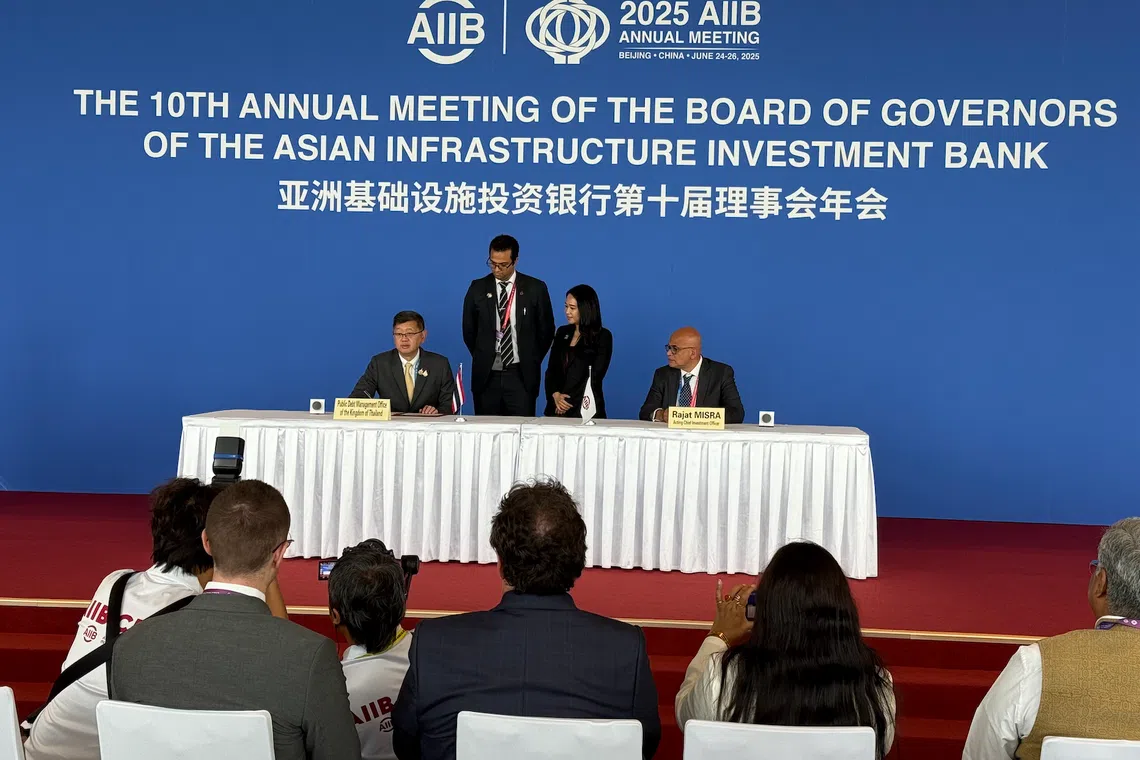China-led AIIB could play a role in Asean power grid, says bank president
Sign up now: Get ST's newsletters delivered to your inbox

A signing ceremony for a loan agreement for the U-Tapao airport expansion project between Thailand and AIIB in Beijing on June 25.
ST PHOTO: LIM MIN ZHANG
Follow topic:
BEIJING - China’s answer to the World Bank marked its 10th year with a pledge to double its annual lending by 2030 and focus on green projects, including in South-east Asia.
These projects could include the Asean power grid
The three-day annual meeting of the Asian Infrastructure Investment Bank (AIIB) in Beijing this week was attended by more than 3,500 people from about 100 countries, including Chinese Premier Li Qiang.
The China-led bank, founded in 2015, has to date approved more than 320 projects in 38 countries, worth some US$60 billion (S$76.3 billion).
Modelled after other multilateral development banks (MBDs) such as the Asian Development Bank (ADB), the AIIB has grown from 57 founding members – including Singapore, Kazakhstan and Saudi Arabia, as well as US allies the UK, Germany and France – to 110 members today, behind only the World Bank, with 189. The US and Japan are not AIIB members.
In his speech on June 26, Mr Li said the AIIB’s successful operation has been a “useful supplement” to traditional multilateral development institutions, and has brought about “incremental reform” to global financial governance.
“Its unique shareholding formula and decision-making rules reflect the new changes in the international economic landscape and raise the voice and influence of emerging markets and developing countries,” he said.
The bank has developing countries as its majority shareholders, with China being by far the largest shareholder at about 27 per cent. The bank markets itself as being based on multilateralism and international standards, and has rejected suggestions that it is controlled by Beijing.
Mr Jin Liqun, who has served as president since the bank’s founding, said in a speech that the AIIB approved US$8.4 billion in financing in 2024, with the aim of doubling the amount of total yearly loans to US$17 billion by 2030. The AIIB’s latest strategy document, approved this week, states that more than half of its financing approvals every year until 2030 will be climate-related.
At a press conference later, he noted that the idea of an Asean power grid was a very important one, in response to a question on the region’s infrastructure development.
He added that the AIIB would have a role to play in this power grid, particularly “to provide renewable energy and build the regional power grid to help sustain the growth of the Asean region”.
On June 24, the bank also elected a new president, Ms Zou Jiayi, who will take office in January 2026. Like Mr Jin, she is a former Chinese vice-finance minister.
MDBs like the AIIB lend billions of dollars a year to support social and economic aims of recipient countries, such as poverty reduction and sustainable development. Asia, in particular, faces an estimated infrastructure financing gap of US$500 billion a year till 2030.
At the Beijing event, a signing ceremony was held for Thailand’s loan of US$423 million for a second runway at U-Tapao Airport in the coastal Rayong province – AIIB’s first sovereign loan to Thailand.
The AIIB is also considering a US$300 million loan to Indonesia for a fixed road crossing from Batam island to Bintan island, via the Tanjung Sauh islands.
Dr Yu Hong, a senior research fellow at the East Asian Institute in Singapore, said the AIIB has achieved a measure of international recognition, contrary to the prognosis of critics in its earlier years who worried about whether its projects would comply with environmental and labour standards.
“AIIB’s success for the last 10 years in terms of its AAA credit rating and expansion of lending has boosted China’s influence and given it confidence... This has also helped China project soft power,” he told The Straits Times. The AIIB received its first AAA credit ratings in 2017.
But Dr Yu, who has done research on the AIIB, believes that the bank has yet to become a “formidable competitor” to other major Western-dominated MDBs – the ADB, World Bank and International Monetary Fund – in terms of infrastructure financing, noting that the AIIB has mostly co-lent with other MDBs.
The AIIB was proposed by Chinese President Xi Jinping in October 2013. Observers saw its creation as stemming from Chinese dissatisfaction with Western dominance of existing international financial institutions – which was not reflective of China’s economic heft.
China’s 27 per cent voting share at the AIIB is far more than its 6 per cent at the World Bank. The AIIB has a multinational staff, including its senior management, which is led by a Chinese national.
The AIIB, while boosting China’s influence overseas, is largely seen as a multilateral organisation that does not warrant politicising by major powers such as the US.
Professor Tamar Gutner of the American University in Washington, who wrote a 2025 book on the AIIB, said that given how deeply MDBs are networked, and that many MDBs have a powerful US role, “I don’t think countries will face pressure not to borrow or to borrow less from the AIIB”.
“The AIIB is clearly a multilateral organisation, not a Chinese organisation. All major donors to MDBs, except for the US and Japan, are AIIB members. However, legitimacy can be fragile, so any move by the AIIB away from its multilateral character could raise questions,” she told ST.
Mr Steward Paterson, a senior fellow at the Hinrich Foundation who has written a book on the trade relationship between the West and China, sees the AIIB’s role as largely symbolic and one that brings prestige to China.
The crucial overseas lending from China has been made by the Export-Import Bank of China and the China Development Bank, he noted. “Their balance sheet dwarfs the AIIB’s.”
The two state-owned banks are crucial funders of China’s Belt and Road Initiative, Beijing’s infrastructure building programme in largely developing countries that is estimated to have funded US$1 trillion worth of projects since its inception in 2013, from roads and railways to ports and energy plants.
Indonesia’s Finance Minister Sri Mulyani Indrawati, in her speech on June 26, said the AIIB was no longer just an emerging bank but a “global force for development”, while urging it to improve the affordability of its financing. Indonesia is a founding member which has worked on 14 projects with the AIIB.
“Many of the member countries in need of infrastructure development are still facing severe fiscal constraints. In today’s high interest rate environment, competitive pricing is critical,” she said.
Lim Min Zhang is China correspondent at The Straits Times. He has an interest in Chinese politics, technology, defence and foreign policies.


